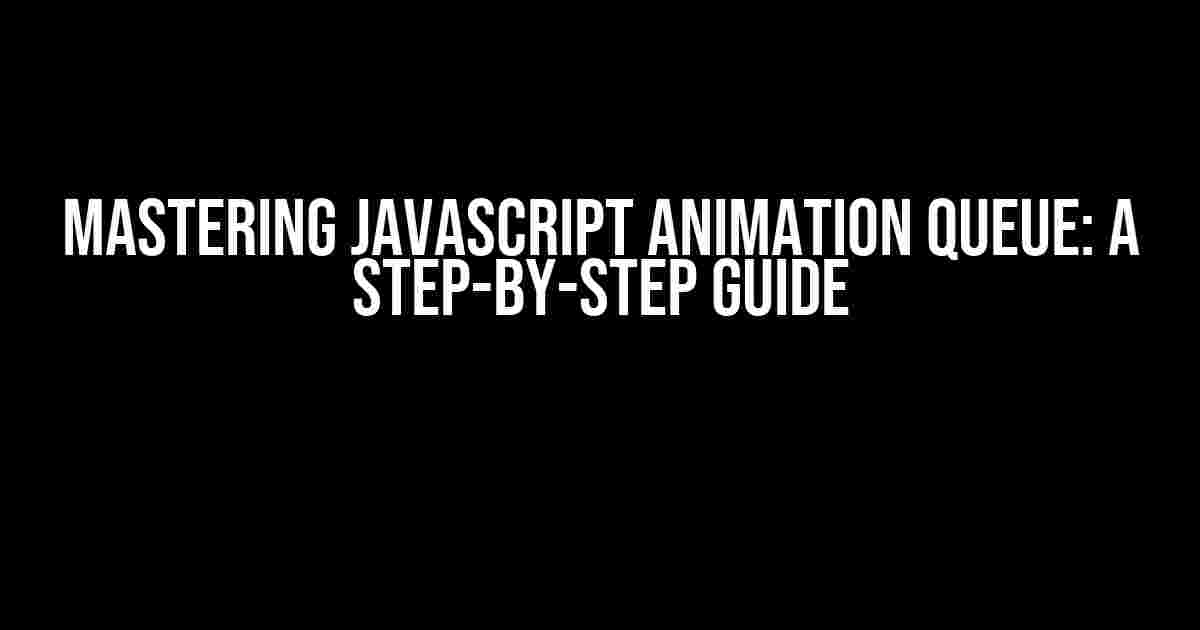Are you tired of juggling multiple animations on your webpage, only to end up with a mess of clashing timers and broken functionality? Do you struggle to maintain a smooth and seamless user experience amidst a slew of concurrent animations? Look no further! In this comprehensive guide, we’ll delve into the world of Javascript animation queue and teach you how to tame the chaos, one animation at a time.
What is a Javascript Animation Queue?
A Javascript animation queue is a mechanism that allows you to sequence and manage multiple animations on your webpage, ensuring that each animation runs smoothly and efficiently without interfering with others. By employing a queue, you can prevent animation conflicts, reduce CPU load, and ultimately enhance the overall user experience.
The Problem with Traditional Animation Approaches
Traditionally, developers would use timers and interval-based approaches to animate elements on a webpage. However, this method has several drawbacks:
- Animation conflicts: Multiple animations running concurrently can lead to clashing timers, resulting in broken functionality and visually unappealing results.
- CPU overload: Excessive timer usage can put a significant strain on the CPU, leading to performance issues and slower page loads.
- Lack of control: Traditional approaches make it challenging to pause, resume, or cancel animations mid-stream, making it difficult to adapt to changing user interactions.
How Does a Javascript Animation Queue Work?
A Javascript animation queue works by creating a centralized hub that manages and sequences animations. Here’s a high-level overview of the process:
- Animation creation: You create multiple animations, each with its own unique characteristics (duration, easing, etc.).
- Queue initialization: You initialize a queue object, which will serve as the central coordinator for all animations.
- Animation registration: You register each animation with the queue, specifying the animation’s properties and dependencies.
- Queue management: The queue takes care of sequencing and managing the animations, ensuring that only one animation runs at a time.
- Animation execution: The queue executes each animation in the sequence, allowing for smooth transitions and preventing conflicts.
Implementing a Basic Javascript Animation Queue
Let’s create a basic animation queue using pure Javascript. We’ll use an array to store the animations and implement a simple sequencing mechanism.
<script>
const animationQueue = [];
function addAnimation(animation) {
animationQueue.push(animation);
}
function runAnimations() {
const currentAnimation = animationQueue.shift();
if (currentAnimation) {
currentAnimation.run();
setTimeout(runAnimations, currentAnimation.duration);
}
}
// Example animation object
const animation1 = {
duration: 1000,
run: function() {
console.log("Animation 1 running...");
}
};
const animation2 = {
duration: 500,
run: function() {
console.log("Animation 2 running...");
}
};
addAnimation(animation1);
addAnimation(animation2);
runAnimations();
</script>
Advanced Animation Queue Techniques
Now that we’ve covered the basics, let’s explore some advanced techniques to take your animation queue to the next level:
Animation Chaining
Animation chaining allows you to create complex animation sequences by linking multiple animations together. This technique enables you to create smooth transitions between animations and ensures a seamless user experience.
| Animation ID | Duration | Next Animation ID |
|---|---|---|
| Anim 1 | 1000 | Anim 2 |
| Anim 2 | 500 | Anim 3 |
| Anim 3 | 2000 | null |
Animation Prioritization
In scenarios where multiple animations have different priorities, you can implement a prioritization system to ensure that critical animations take precedence. This can be achieved by assigning a priority score to each animation and sorting the queue accordingly.
<script>
const animationQueue = [];
function addAnimation(animation, priority) {
animationQueue.push({ animation, priority });
animationQueue.sort((a, b) => b.priority - a.priority);
}
// Example animation objects with priorities
const animation1 = {
duration: 1000,
run: function() {
console.log("High-priority animation running...");
},
priority: 10
};
const animation2 = {
duration: 500,
run: function() {
console.log("Low-priority animation running...");
},
priority: 5
};
addAnimation(animation1, 10);
addAnimation(animation2, 5);
runAnimations();
</script>
Animation Canceling and Pausing
Sometimes, you need to cancel or pause an animation mid-stream. To achieve this, you can add cancel and pause methods to your animation objects and update the queue accordingly.
<script>
const animationQueue = [];
function addAnimation(animation) {
animationQueue.push(animation);
}
function cancelAnimation(animationId) {
const animationIndex = animationQueue.findIndex(animation => animation.id === animationId);
if (animationIndex !== -1) {
animationQueue.splice(animationIndex, 1);
}
}
function pauseAnimation(animationId) {
const animationIndex = animationQueue.findIndex(animation => animation.id === animationId);
if (animationIndex !== -1) {
animationQueue[animationIndex].paused = true;
}
}
// Example animation object with cancel and pause methods
const animation1 = {
id: "anim-1",
duration: 1000,
run: function() {
console.log("Animation running...");
},
cancel: function() {
console.log("Animation canceled...");
},
pause: function() {
console.log("Animation paused...");
}
};
addAnimation(animation1);
cancelAnimation("anim-1");
pauseAnimation("anim-1");
</script>
Best Practices for Working with Javascript Animation Queue
Here are some best practices to keep in mind when working with a Javascript animation queue:
- Keep it simple: Avoid over-engineering your animation queue. Focus on simplicity and ease of use.
- Use a modular approach: Break down complex animations into smaller, reusable modules.
- Test thoroughly: Ensure your animation queue is thoroughly tested to prevent unexpected behavior.
- Optimize for performance: Optimize your animation queue for performance by minimizing CPU load and reducing unnecessary computations.
Conclusion
Mastering the art of Javascript animation queue requires patience, practice, and a deep understanding of animation principles. By following the techniques and best practices outlined in this guide, you’ll be well on your way to creating stunning, conflict-free animations that captivate and engage your users. Remember to keep it simple, test thoroughly, and prioritize performance to ensure a seamless user experience.
So, what are you waiting for? Get started with your own Javascript animation queue today and unlock the full potential of animations on your webpage!
Frequently Asked Questions
Got questions about JavaScript animation queue? We’ve got answers!
What is a JavaScript animation queue?
A JavaScript animation queue is a mechanism that allows you to control the order and pace of animations on your website or application. It’s like a line of animations waiting to happen, and you get to decide when and how they’re executed!
Why do I need a JavaScript animation queue?
You need a JavaScript animation queue to avoid animation chaos! Without it, multiple animations might fire at the same time, causing a cluttered and confusing user experience. A queue helps you manage animations, ensuring a smooth and synchronized visual flow.
How does a JavaScript animation queue work?
A JavaScript animation queue works by stacking animations in a First-In-First-Out (FIFO) order. When an animation is added to the queue, it waits for its turn to be executed. Once the previous animation completes, the next one in the queue is triggered, and so on. You can also add pauses, delays, or conditions to control the flow of animations.
Can I use JavaScript animation queues with popular front-end frameworks?
Absolutely! JavaScript animation queues can be used with popular front-end frameworks like React, Angular, and Vue.js. You can integrate queueing libraries or plugins into your framework of choice, making it easy to manage animations and create a seamless user experience.
Are JavaScript animation queues compatible with different browsers?
Yes, JavaScript animation queues are generally compatible with different browsers, including Chrome, Firefox, Safari, and Edge. However, it’s essential to test your implementation thoroughly to ensure that it works as expected across various browsers and versions.




